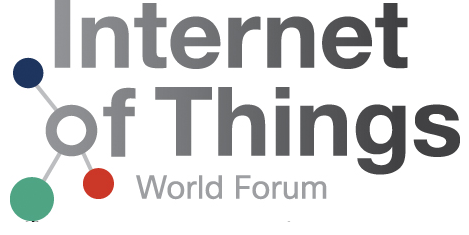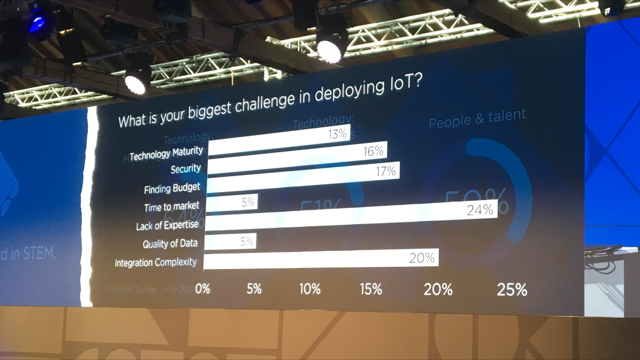IoT World Forum: Mind The Skills Gap With Insights Services
 IoT World Forum 2017 has just wrapped up and the biggest takeaway for me was the skills gap. Companies don’t have the expertise to fully implement and benefit from their IoT initiatives.
IoT World Forum 2017 has just wrapped up and the biggest takeaway for me was the skills gap. Companies don’t have the expertise to fully implement and benefit from their IoT initiatives.
This was the fourth year of the event, with a theme of “taking IoT to the next level” and “bringing it all together.” The organizers were clear on their mission to help the audience with concrete “how to” sessions. As a moderator of one of the main stage panels I was instructed to make sure the discussion wasn’t just a review of the limitless possibilities of IoT – the theme of a previous forum – but rather to discuss how to make IoT stick and scale – to get beyond the pilot. That hasn’t been easy for many companies undertaking IoT initiatives.
 In a recent study sponsored by Cisco, 62% of respondents reported that the IoT opportunity was real, but that they had barely scratched the surface. The same study also found that only 26% of IoT initiatives were completely successful and 15% failed. That means that the rest are somewhere in the middle, potentially stalled – but with some hope remaining. The same survey asked about the challenges they faced in implementing IoT initiatives; the results are telling. The #1 challenge was lack of expertise, followed by integration complexity – challenges that each exacerbates the other. Fifty percent of respondents reported that they planned to increase their investments in people and talent. According to another speaker, the head of HR for GE, there are 300,000 jobs in IoT today, and that’s expected to grow to 1.3 million in 3 years. The skill sets required for those jobs vary but many of them would include data and analytics expertise. As we've said before, IoT and insights are two sides of the same coin. And, we know that data engineers and scientists are in short supply.
In a recent study sponsored by Cisco, 62% of respondents reported that the IoT opportunity was real, but that they had barely scratched the surface. The same study also found that only 26% of IoT initiatives were completely successful and 15% failed. That means that the rest are somewhere in the middle, potentially stalled – but with some hope remaining. The same survey asked about the challenges they faced in implementing IoT initiatives; the results are telling. The #1 challenge was lack of expertise, followed by integration complexity – challenges that each exacerbates the other. Fifty percent of respondents reported that they planned to increase their investments in people and talent. According to another speaker, the head of HR for GE, there are 300,000 jobs in IoT today, and that’s expected to grow to 1.3 million in 3 years. The skill sets required for those jobs vary but many of them would include data and analytics expertise. As we've said before, IoT and insights are two sides of the same coin. And, we know that data engineers and scientists are in short supply.
 Fortunately, there is more than one solution to the skills gap – particularly around data and analytics. Insights service providers can help ensure the success of an IoT initiative. Ultimately, the goal of IoT is to capture data from connected objects, derive insights into usage patterns, maintenance needs, security concerns, etc. and prescribe actions that deliver business value. And, that’s what insights service providers do best. Typically the insights service cycle would start with the business problem rather than the technology. And, ideally, an IoT initiative would have been launched to address a business issue and not as a hammer looking for a nail.
Fortunately, there is more than one solution to the skills gap – particularly around data and analytics. Insights service providers can help ensure the success of an IoT initiative. Ultimately, the goal of IoT is to capture data from connected objects, derive insights into usage patterns, maintenance needs, security concerns, etc. and prescribe actions that deliver business value. And, that’s what insights service providers do best. Typically the insights service cycle would start with the business problem rather than the technology. And, ideally, an IoT initiative would have been launched to address a business issue and not as a hammer looking for a nail.
Many industrial products companies offer an integrated insights service. Siemens Mobility offers insights services to optimize train availability. GE Aviation offers predictive maintenance and other flight operations insights services. Honeywell, whose VP of supply chain participated on the IoT World Forum panel, offers insights into a connected supply chain. At Forrester, we’ve written about both industry-specific and domain-specific insights service providers. And, the broader insights service providers – recently evaluated in our insights service provider wave – can help with a wide range of business questions, providing the expertise to bridge the skills gaps in data and analytics. Many of them can help with the IoT side of things. As Cisco’s IoT survey revealed, “the most successful organizations engage the IoT partner ecosystem at every stage, implying that strong partnerships throughout the process can smooth out the learning curve.” For IoT data and analytics, partnering with an insights service provider can bridge the gap.